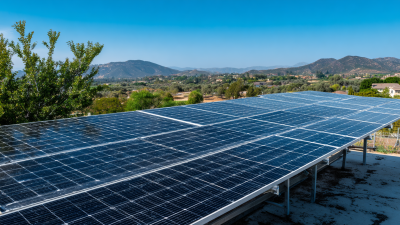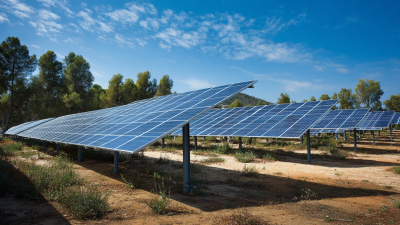Blog
10 Surprising Reasons Solar Power Will Dominate the Energy Market by 2030
In recent years, solar power has emerged as a leading force in the global energy landscape, with forecasts predicting its dominance in the market by 2030. According to the International Energy Agency (IEA), installed solar capacity is expected to grow by more than 600% in the next decade, making it the fastest-growing renewable energy source. This remarkable surge is driven by decreasing costs—Solar photovoltaic (PV) prices have plummeted by around 85% since 2010, according to the World Bank—along with advancements in technology and increased adoption of sustainable practices by governments and industries alike. As countries strive to meet ambitious climate targets, it becomes clear that solar power is not just a powerful alternative but a necessary solution to the global energy crisis. In this blog, we will explore ten surprising reasons why solar power will dominate the energy market by 2030, highlighting the transformative potential of this renewable resource.

Factors Driving the Decline of Fossil Fuels in Favor of Solar Energy
The shift towards solar energy is being propelled by several compelling factors that highlight the declining relevance of fossil fuels. As global decarbonization plans push for zero-carbon energy sources by the middle of the century, solar power emerges as a frontrunner. Not only is it more accessible and cost-effective compared to traditional fossil fuels, but advancements in photovoltaic technology keep enhancing its efficiency and scalability. Renewable energy sources like solar and wind are increasingly being recognized for their minimal greenhouse gas emissions, presenting a viable alternative to coal, oil, and gas.

Moreover, regions like Indonesia are setting ambitious targets to expand clean power, ensuring that no new coal plants will be necessary to meet growing electricity demands. This commitment not only fosters sustainable energy development but also promotes equality and economic growth. Despite challenges in the United States where increased renewable adoption doesn't immediately equate to reduced fossil fuel usage, the momentum of the renewable energy sector continues to gain ground. Reports indicate that renewable energy is vastly outpacing fossil fuel additions, underscoring a transition that is unlikely to slow down, paving the way for a solar-dominated energy market by 2030.
Technological Innovations Making Solar Power More Accessible and Efficient
The solar power industry is poised to transform the energy market by 2030, driven by a wave of technological innovations that make solar solutions more accessible and efficient than ever before. One of the most significant advancements in recent years is the development of high-efficiency photovoltaic cells. These cells can convert a greater percentage of sunlight into electricity, significantly increasing energy output without requiring more space. As manufacturers continue to refine these technologies, it's becoming possible to install solar panels in a wider range of environments, from urban rooftops to rural areas, expanding access where sunlight is abundant.
Another game-changing innovation is the rise of energy storage solutions, such as advanced lithium-ion batteries and innovative energy management systems. By enabling homeowners and businesses to store excess solar energy generated during peak sunlight hours, these technologies provide a reliable power source even when the sun isn't shining. This capability not only enhances energy security but also allows users to maximize their investment in solar technology, making it a more attractive option for a broader audience. As these advancements gain traction, the solar market will continue to grow, reshaping how we think about and utilize energy in the coming decade.
The Role of Government Policies and Incentives in Solar Market Growth
Government policies and incentives play a pivotal role in the growth of the solar energy market, with projections indicating a remarkable expansion in the sector. According to industry reports, the global solar crystalline wafer market is expected to surge from $53.89 billion in 2025 to approximately $100.6 billion by 2032, marking a compound annual growth rate (CAGR) of 10.15%. Such robust growth is largely driven by supportive government initiatives aimed at promoting renewable energy sources.
Similarly, the utility-scale solar photovoltaic (PV) Engineering, Procurement, and Construction (EPC) market is anticipated to escalate significantly from $59.36 billion in 2023 to $110.2 billion by 2032. This dramatic increase underscores the pressing need for effective government policies that not only boost market confidence but also facilitate investments in clean energy infrastructure. As governments worldwide continue to introduce and strengthen incentive programs, the solar market is poised for unprecedented growth.
**Tip:** For those looking to invest in solar energy projects, staying informed about local and federal incentives can optimize financial outcomes. Exploring state-sponsored rebates and tax credits can further enhance the feasibility and profitability of solar investments. Additionally, engaging with experienced EPC contractors can help navigate the complexities of project implementation in a rapidly evolving market.
| Reason | Impact on Solar Market | Expected Growth (%) | Government Incentive Type |
|---|---|---|---|
| Decreasing Costs of Solar Installations | Increased adoption by households and businesses | 25% | Tax Credits |
| Technological Advancements | Higher efficiency in solar panels | 30% | Research Grants |
| Rising Energy Demand | More investment in renewable sources | 20% | Subsidies |
| Public Awareness of Climate Change | Increased interest in sustainable energy | 35% | Awareness Campaigns |
| Global Policy Initiatives | Support for international solar projects | 40% | International Agreements |
| Innovative Financing Solutions | Lower upfront costs for consumers | 28% | Financing Programs |
| Corporate Social Responsibility | Investment in renewable projects | 22% | Corporate Incentives |
| Job Creation in Renewables | Increased workforce in solar sectors | 33% | Job Training Programs |
| Grid Modernization | Compatibility with solar technologies | 18% | Infrastructure Grants |
| Increased Energy Independence | Reduction in reliance on fossil fuels | 27% | Renewable Energy Policies |
Consumer Trends Shifting Towards Sustainable Energy Solutions
In recent years, consumer trends have rapidly shifted towards sustainable energy solutions, reflecting a growing awareness of climate change and the environmental impact of fossil fuels. According to a report by the International Renewable Energy Agency (IRENA), global investment in renewable energy is expected to reach $1 trillion annually by 2030, with solar power leading the way. The demand for clean energy alternatives, like solar, is being driven not only by environmental concerns but also by increasing energy costs and the desire for energy independence.
Additionally, a survey conducted by the Solar Energy Industries Association (SEIA) revealed that 90% of consumers are interested in solar energy, citing long-term savings and resilience against energy price fluctuations as primary motivations for their interest. This trend is further supported by the increasing availability of government incentives and financing options, which make solar installations more accessible to homeowners and businesses alike. As consumers gravitate towards energy solutions that offer both ecological benefits and economic savings, it is clear that solar power is poised to become a dominant player in the energy market by 2030.
Growth of Solar Power Adoption by 2030
The Impact of Climate Change Awareness on Solar Energy Adoption
The growing awareness of climate change has played a crucial role in accelerating the adoption of solar energy. As the impacts of global warming become increasingly apparent, consumers and businesses alike are seeking sustainable energy solutions. According to a report by the International Energy Agency, solar power capacity increased by 22% globally in 2020, despite the economic downturn caused by the pandemic. This surge can be attributed in part to heightened public concern about climate change and the desire to reduce carbon footprints.
Moreover, a survey conducted by the Pew Research Center indicated that a significant 79% of Americans view climate change as a major threat, which has intensified calls for cleaner energy sources. This shift in consumer sentiment is reflected in the market dynamics, as the Solar Energy Industries Association predicts that solar power will continue to become more affordable and accessible. By 2030, solar energy could account for over 20% of the U.S. electricity generation, driven by policies favoring renewable energy and the decreasing costs of solar technology. As awareness of climate change continues to influence both policy and purchasing decisions, the solar energy sector is poised for exponential growth.

Related Posts
-

10 Remarkable Reasons to Choose a Solar Panel System for Your Home
-

Emerging Trends in Solar Energy for the Best Solar Panels by 2025
-

How to Choose the Right Off Grid Solar System for Your Home
-

Solutions for Maximizing Efficiency with Your DIY Solar System
-

Essential Checklist for Installing Roof Solar Panels to Maximize Energy Efficiency
-

How to Choose the Best Free Solar Panels for Your Business: A Comprehensive Guide

